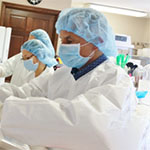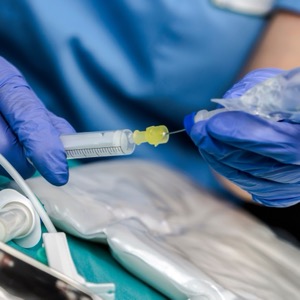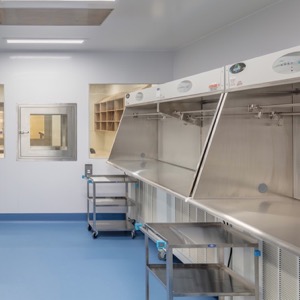Competency testing is the “foundation of everything” involved in sterile compounding safety, said Krystal Stefanyk, the director of inspections at the North Carolina Board of Pharmacy. “Even if you’ve spared no expense and have the ‘Cadillac’ of cleanrooms, it doesn’t matter if your compounding staff isn’t properly trained and their competency rigorously tested.”
Ms. Stefanyk was speaking with Pharmacy Practice News after the March 2025 American Pharmacists Association meeting in Nashville, Tenn., where she delivered a talk on the importance of the enhanced competency assessment guidelines in the revised USP Chapter <797>, which became effective in November 2023.
Based on her experience at the helm of the North Carolina pharmacy board’s inspection team, Ms. Stefanyk said that the USP revisions had “absolutely” improved sterile compounding practice and patient safety. The chapter’s 2008 version often “left too much to interpretation,” she said. Pharmacy boards “really had to grapple” with their intent. Now everything is “clearly spelled out” and that has meant “much less pushback from our pharmacies.”
One key change in the revised chapter focuses on the frequency of competency testing. How often it needs to be done now depends on the risk level of compounded sterile preparations (CSPs). Those with the highest level of complications and risk are considered Category 3 CSPs and require competency assessments every three months. Categories 1 and 2 compounders should be tested twice a year. (ASHP offers a full description of the chapter’s key changes at bit.ly/4jrPGNm.)
In North Carolina, only one of the state’s roughly 250 pharmacies (a major health system that Ms. Stefanyk declined to identify) is currently a Level 3 compounder. Ms. Stefanyk said inspection teams at the most advanced facilities can take several days, whereas inspections at smaller facilities are typically completed in less than a day. The time depends on the number of inspectors assigned, she explained. “We usually have two to three people helping to inspect our larger systems.”
Whatever the size, Ms. Stefanyk said, “we’re looking at the entire compounding process from beginning to end.” Everything undergoes scrutiny, she said, from how master formulas are developed to the way staff is trained and how the compounding environment is monitored—all with an eye to USP standards and state board regulations. “Then we do a walk-through within the cleanroom,” she said. “We’ll gown and garb with the compounding staff, and while we’re doing that, we’re looking to see if their procedures are compliant. Do they match their standard operating procedures? Then we observe what they are requiring us to do to enter their cleanroom. Once we do enter the cleanroom, we observe their aseptic compounding process to see if it conforms to USP <797> standards.”
One factor that can often trip up a pharmacy’s test performance, Ms. Stefanyk said, is that the aseptic manipulation evaluation fails to represent the facility’s most complex formulations. “We always make sure that the performance matches their most demanding procedures.”
Failure to do so means repeating the entire aseptic manipulation portion of the test, from media fill to surface sampling, said Patricia Kienle, RPh, MPA, BCSCP, FASHP, the director of accreditation and medication safety at Cardinal Health. She told PPN that in her visits to compounding pharmacies, she very rarely sees the aseptic manipulation test failed. But that’s not necessarily an indication of high performance: more compounders might fail if they increased the sophistication of the media fill test, she noted.
Hand Hygiene and Garbing
Demonstrating competence in hand hygiene and garbing is the other half of the hands-on cleanroom test, and it can be challenging. Compounding teams have to wash their hands, garb and do a fingertip test for possible contamination—and then repeat everything two more times. A misstep means redoing the entire process three more times. Although not required under the revised USP standard, Ms. Kienle said she favors repeating the hand hygiene and garbing component on three separate occasions. “It’s just more reflective of actual practice when it’s done on different days,” she noted.
Ms. Kienle also stressed the importance of the person designated as “responsible and accountable for the performance and operation of the facility and personnel in the preparation of CSPs,” in the words of the USP chapter. This designated person, she said, should be someone who knows every aspect of the institution’s compounding operations. “They should have [a] checklist that includes all requirements in USP <797> as well as the institution’s specific regulations.”
Ms. Kienle said complying with the strengthened USP <797> competency training requirements hasn’t been much of a challenge for large institutions with ample resources. “But there are plenty of hospitals out there where there may be one pharmacist and one tech on at any given time, especially in rural areas. So how does that person get the necessary training?”
The answer, Ms. Kienle said, is that there are many CSP training programs available, especially online. Her personal belief, although not a <797> requirement, is that the training program should be hands-on and led by “somebody who really knows what’s going on.”
She had two suggestions: the sterile compounding competency training program scheduled for the ASHP Pharmacy Futures 2025 meeting, and PureMicrobiology’s interactive training services for pharmacists and technicians.
“There are opportunities, even for small [facilities],” Ms. Kienle said. “Granted, they’re limited, and it’s going to cost people in time and registration fees. But again, considering the patient safety issue, how would we be expected to know what to do unless somebody has appropriately taught us to do it?” (For Ms. Kienle’s full discussion of the revised USP guidelines, see bit.ly/42u1B6r-PPN.)
Ms. Kienle is an employee of Cardinal Health and a member of the USP Compounding Expert Committee. The comments in this article are her own. Ms. Stefanyk reported no relevant financial disclosures.
This article is from the May 2025 print issue.





